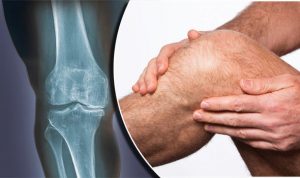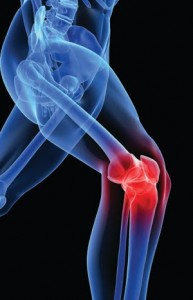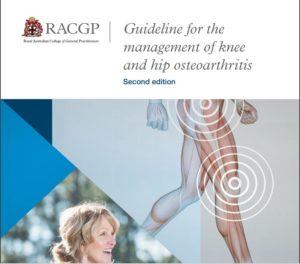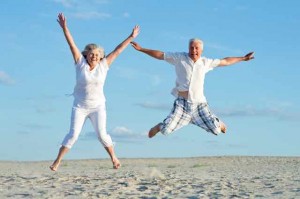Why Does Exercise Help Reduce Knee Pain in Knee Osteoarthritis?
By Physio & registered GLA:D Therapist, Sam Mclaren
 A very common belief held by patients with knee Osteoarthritis (OA defined as a degenerative joint pathology) is that their knee pain is caused by the current degeneration and degradation of the cartilage within their knee joint i.e. “wear and tear”.
A very common belief held by patients with knee Osteoarthritis (OA defined as a degenerative joint pathology) is that their knee pain is caused by the current degeneration and degradation of the cartilage within their knee joint i.e. “wear and tear”.

As it progresses to “bone on bone” with sensations of stiffness and cracking/crunching/grinding noises, we can develop an image or representation of our knee such as a rusted out car part, that eventually with more repeated movements and forces will one day break. We may be told to avoid high impact activities such as running and jumping in order to protect the knee, and perhaps delay a few years the inevitable – getting that rusty part replaced for a new shiny artificial one in the form of a total knee replacement. BUT IS THAT WHAT ACTUALLY HAPPENS????
And what about the role of Exercise in “fixing” this knee OA?
On a knee that already hurts by doing not much at all, like walking to the letterbox, taking a few stairs to your seat at the footy or even just sitting in the car to work, can exercise actually heal the cartilage damage and improve the ‘wear & tear”????
Luckily, unlike a car, our body is made up of many complex biological systems that have an amazing ability to change and adapt. And we also know that osteoarthritis is a condition that isn’t solely based on structural damage to the joint. Many people develop structural changes within their knee joint that via an X-ray would be diagnosed as knee OA but they have NO pain or limitations doing the things they love to do. How is this so?

You see, the pain from osteoarthritis is always going to be the result of many different factors that are individual to you. Rather than focus on only the structural changes within the knee joint (such as a reduction in the amount of cartilage that covers the bony surface – as these are definitely still a factor), there may be several other factors that can manage to alter pain and functional loss.
Experts in the field now view osteoarthritis as a process rather than an entity, where the normal systems that keep our bodies running at a stable equilibrium (i.e. homeostasis) are altered, with inflammation likely being a key contributor. Inflammatory chemicals sensitise the nerves in our pain system, which there are many within the knee joint and surrounding soft tissue structures.
Our general levels of inflammation within the body can be contributed to by many different factors – our overall level of exercise, our diet and nutrition, our proportion of fat mass vs lean mass, sleep quality and quantity and stress levels, genetics and likely several more all will impact. But for each individual, some of these may be very important and others less so. In the mind of a great Physio, high value patient care is about your physio being your individual coach – we can help you manage these various factors in a way that is tailored to your situation as a person holistically.
Back to the role of exercise
 We know from over 50 high quality scientific trials and the consensus of international experts (and development of several clinical guidelines) that ALL patients with knee OA should be offered exercised-based therapy, weight loss management if they are obese and high quality education about the condition and best self-management strategies!!
We know from over 50 high quality scientific trials and the consensus of international experts (and development of several clinical guidelines) that ALL patients with knee OA should be offered exercised-based therapy, weight loss management if they are obese and high quality education about the condition and best self-management strategies!!
However, it seems that at least within these trials that there isn’t clear if one specific type of exercise is better than others, therefore the exact mechanism why exercise reduces knee pain isn’t perfectly understood yet. A combination of aerobic and resistance based exercise that is performed at least two to three times per week seems to be the best at providing a minimum dosage of exercise that the knee will start to improve with.
There is a new program worldwide called the GLA:D® program for Hip & Knee OA (or “Good Life with Arthritis: Denmark”). It is an education and exercise program developed by researchers in Denmark that helps people with hip or knee osteoarthritis symptoms have less pain and improve function – so they can do all the things they want to do! Gold Coast Physio & Sports Health has the program running in Clinic and early patient data from the GLA:D program has revealed many great improvements from just twice weekly supervised sessions for 6 weeks (see our GLA:D info here).
Generally, with long term pain your body and brain has probably developed some movement strategies that aren’t really optimal for building capacity around the knee. Moving in this way can then cause ongoing stiffness and weakness, and when we lack strong, robust muscle control around the knee (and also the hips and trunk), we can get caught up in a vicious cycle of pain and further functional declines that tends to limit our independence as we get older.
 Therefore a high skilled and experienced physiotherapist (*cough cough- insert “We can Help you here”) can find the right entry point of exercise for your knee, based on your history and movement patterns. Sometimes a subtle tweak in technique, an exercise selection or manipulation of other variables such as intensity (how ‘hard’ an exercise is on the system) and volume (how many repetitions of an exercise you do) is all it takes to start to find the perfect exercise dosage for your knee. Too little and we don’t challenge our system enough in order for it to adapt, and too much too soon will often result in a painful flare-up. Some mild discomfort is perfectly normal to begin with, but this decreases with time and we always ensure it’s never to a bothersome level where it interferes negatively with your life.
Therefore a high skilled and experienced physiotherapist (*cough cough- insert “We can Help you here”) can find the right entry point of exercise for your knee, based on your history and movement patterns. Sometimes a subtle tweak in technique, an exercise selection or manipulation of other variables such as intensity (how ‘hard’ an exercise is on the system) and volume (how many repetitions of an exercise you do) is all it takes to start to find the perfect exercise dosage for your knee. Too little and we don’t challenge our system enough in order for it to adapt, and too much too soon will often result in a painful flare-up. Some mild discomfort is perfectly normal to begin with, but this decreases with time and we always ensure it’s never to a bothersome level where it interferes negatively with your life.
As you may have heard, Sam is now commencing GLA:D (Good Living with Arthritis) Exercise Program in small groups in clinic. Call the clinic for more info on 07 55006470 – if you have knee or hip OA and are struggling to do the things that make you happy, Sam would love the opportunity to help!
